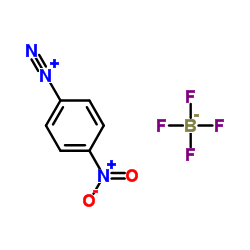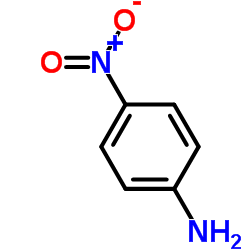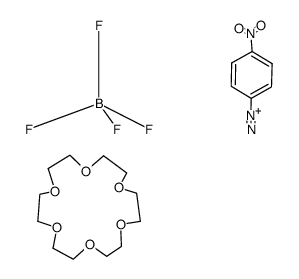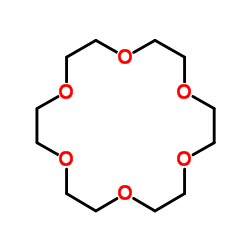4-Nitrophenyldiazonium tetrafluoroborate

4-Nitrophenyldiazonium tetrafluoroborate structure
|
Common Name | 4-Nitrophenyldiazonium tetrafluoroborate | ||
|---|---|---|---|---|
| CAS Number | 456-27-9 | Molecular Weight | 236.919 | |
| Density | N/A | Boiling Point | N/A | |
| Molecular Formula | C6H4BF4N3O2 | Melting Point | 144-148 °C (dec.) | |
| MSDS | Chinese USA | Flash Point | N/A | |
| Symbol |


GHS05, GHS07 |
Signal Word | Danger | |
| Name | 4-Nitrobenzenediazonium Tetrafluoroborate |
|---|---|
| Synonym | More Synonyms |
| Melting Point | 144-148 °C (dec.) |
|---|---|
| Molecular Formula | C6H4BF4N3O2 |
| Molecular Weight | 236.919 |
| Exact Mass | 237.033264 |
| PSA | 73.97000 |
| LogP | 3.90258 |
| Storage condition | 2-8°C |
| Stability | Stable. Incompatible with strong oxidizing agents, moisture, strong bases. Avoid mechanical shock. |
CHEMICAL IDENTIFICATION
HEALTH HAZARD DATAACUTE TOXICITY DATAMUTATION DATA
|
| Symbol |


GHS05, GHS07 |
|---|---|
| Signal Word | Danger |
| Hazard Statements | H302 + H312 + H332-H314 |
| Precautionary Statements | P280-P305 + P351 + P338-P310 |
| Personal Protective Equipment | Eyeshields;Faceshields;full-face particle respirator type N100 (US);Gloves;respirator cartridge type N100 (US);type P1 (EN143) respirator filter;type P3 (EN 143) respirator cartridges |
| Hazard Codes | Xn,Xi,C |
| Risk Phrases | R20/21/22 |
| Safety Phrases | S22-S24/25-S36/39-S45-S36/37/39-S26 |
| RIDADR | UN 1759 8/PG 2 |
| WGK Germany | 3 |
| RTECS | CZ1723000 |
| Packaging Group | III |
| Hazard Class | 8 |
|
~95% 
4-Nitrophenyldi... CAS#:456-27-9 |
| Literature: Parola, Stephane; Desroches, Cedric; Vocanson, Francis; Bouix, Jean; Lamartine, Roger Patent: US2004/127722 A1, 2004 ; Location in patent: Page 7 ; |
|
~% 
4-Nitrophenyldi... CAS#:456-27-9 |
| Literature: Izatt, R. M.; Lamb, J. D.; Swain, C. S.; Christensen, J. J.; Haymore, Barry L. Journal of the American Chemical Society, 1980 , vol. 102, # 9 p. 3032 - 3034 |
|
Electrografted diazonium salt layers for antifouling on the surface of surface plasmon resonance biosensors.
Anal. Chem. 87(4) , 2488-94, (2015) Electrografted diazonium salt layers on the surface of surface plasmon resonance (SPR) sensors present potential for a significant improvement in antifouling coatings. A pulsed potential deposition pr... |
|
|
Development and investigation of a dual-pad in-channel referencing surface plasmon resonance sensor.
Anal. Chem. 84(18) , 7891-8, (2012) Herein, we describe the construction of a novel dual-pad referencing surface plasmon resonance (SPR) sensor utilizing electrolytic grafting of diazonium salts to individually functionalize two gold pa... |
|
|
[Modification of two tyrosine residues in aspergillopepsin A by p-nitrophenyldiazonium chloride].
Biokhimiia 46(2) , 369-75, (1981) p-Nitrophenyldiazonium chloride was found to modify the Tyr-75 and Tyr-189 residues in aspergillopepsin A. Incubation of the protein with a 45-fold molar excess of the reagent at pH 5,2 results in the... |
| Azoic Diazo No. 37,Fast Red GG salt |
| 4-Nitrobenzenediazonium tetrafluoroborate |
| EINECS 207-261-1 |
| p-Nitrobenzenediazonium tetrafluoroborate |
| p-Nitrophenyldiazonium tetrafluoroborate |
| 4-Nitrophenyldiazonium tetrafluoroborate |
| 4-Nitrobenzenesiazonium Tetrafluoroborate |
| MFCD00012005 |




